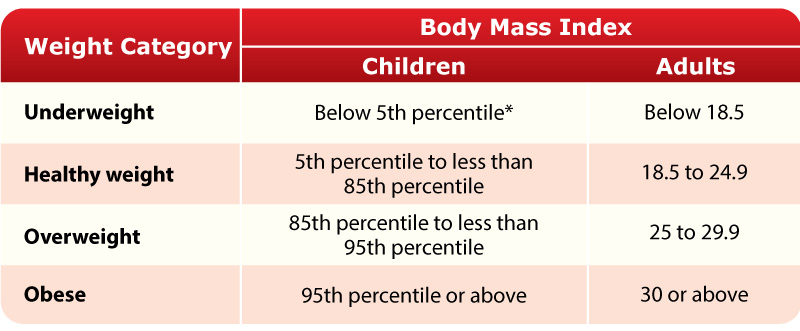Overweight and Obesity - Signs, Symptoms, and Complications - Signs, Symptoms, and Complications
There are no specific symptoms of overweight and obesity. The signs of overweight and obesity include a high body mass index (BMI) and an unhealthy body fat distribution that can be estimated by measuring your waist circumference. Obesity can cause complications in many parts of your body.
High body mass index (BMI)
-
Overweight and Obesity - Signs, Symptoms, and Complications
A high BMI is the most common sign of overweight and obesity.
Body mass index (BMI) is used to determine if you or your child are underweight, healthy, or overweight or obese. Children are underweight if their BMI is below the 5th percentile, healthy weight if their BMI is between the 5th to less than the 85th percentile, overweight if their BMI is the 85th percentile to less than the 95th percentile, and obese if their BMI is the 95th percentile or above. Adults are underweight if their BMI is below 18.5, healthy weight if their BMI is 18.5 to 24.9, overweight if their BMI is 25 to 29.9, and obese if their BMI is 30 or above. *A child’s BMI percentile is calculated by comparing your child’s BMI to growth charts for children who are the same age and sex as your child.
Unhealthy body fat distribution
-
Overweight and Obesity - Signs, Symptoms, and Complications
Another sign of overweight and obesity is having an unhealthy body fat distribution. Fatty tissue is found in different parts of your body and has many functions. Having an increased waist circumference suggests that you have increased amounts of fat in your abdomen. An increased waist circumference is a sign of obesity and can increase your risk for obesity-related complications.
Did you know that fatty tissue has different functions depending on its location in your body?
Visceral fat is the fatty tissue inside of your abdomen and organs. While we do not know what causes the body to create and store visceral fat, it is known that this type of fat interferes with the body’s endocrine and immune systems and promotes chronic inflammation and contributes to obesity-related complications.
Complications
-
Overweight and Obesity - Signs, Symptoms, and Complications
Obesity may cause the following complications:
- Metabolic Syndrome
- Type 2 diabetes
- High blood cholesterol and high triglyceride levels in the blood
- Diseases of the heart and blood vessels such as high blood pressure, atherosclerosis, heart attacks and stroke
- Respiratory problems such as obstructive sleep apnea, asthma, and obesity hypoventilation syndrome
- Back pain
- Non-alcoholic fatty liver disease (NAFLD)
- Osteoarthritis, a chronic inflammation that damages the cartilage and bone in or around the affected joint. It can cause mild or severe pain and usually affects weight-bearing joints in people who are obese. It is a major cause of knee replacement surgery in patients who are obese for a long time.
- Urinary incontinence, the unintentional leakage of urine. Chronic obesity can weaken pelvic muscles, making it harder to maintain bladder control. While it can happen to both sexes, it usually affects women as they age.
- Gallbladder disease
- Emotional health issues such as low self-esteem or depression. This may commonly occur in children.
- Cancers of the esophagus, pancreas, colon, rectum, kidney, endometrium, ovaries, gallbladder, breast, or liver.
Did you know inflammation is thought to play a role in the onset of certain obesity-related complications?
Researchers now know more about visceral fat, which is deep in the abdomen of overweight and obese patients. Visceral fat releases factors that promote inflammation. Chronic obesity-related inflammation is thought to lead to insulin resistance and diabetes, changes in the liver or non-alcoholic fatty acid liver disease, and cancers. More research is needed to understand what triggers inflammation in some obese patients and to find new treatments.
Look for
-
Overweight and Obesity - Signs, Symptoms, and Complications
- Diagnosis will explain tests and procedures used to detect signs of overweight and obesity and help rule our other conditions that may be causing weight gain.
- Treatment will discuss treatment-related complications or side effects.
- Living With will explain how doctors use waist circumference to monitor for disease severity and check for complications.


